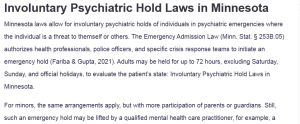Involuntary Psychiatric Hold Laws in Minnesota
Minnesota laws allow for involuntary psychiatric holds of individuals in psychiatric emergencies where the individual is a threat to themself or others. The Emergency Admission Law (Minn. Stat. § 253B.05) authorizes health professionals, police officers, and specific crisis response teams to initiate an emergency hold (Fariba & Gupta, 2021). Adults may be held for up to 72 hours, excluding Saturday, Sunday, and official holidays, to evaluate the patient’s state: Involuntary Psychiatric Hold Laws in Minnesota.
For minors, the same arrangements apply, but with more participation of parents or guardians. Still, such an emergency hold may be lifted by a qualified mental health care practitioner, for example, a psychiatrist or psychologist, if the patient no longer qualifies for the hold. Family members, legal guardians, or designated caregivers who can provide for the safety of the patient may pick them up once the hold is over.
Emergency Hospitalization, Inpatient, and Outpatient Commitments
Minnesota distinguishes between involuntary hospitalization for the emergency, involuntary inpatient commitment, and involuntary outpatient commitment depending on the need of the individual and the nature of the disorder. Emergency hospitalization is just to stabilize the patient while doing all possible assessments before deciding the future course of action (Morris & Kleinman, 2022). From this temporary phase of hospitalization, one may get into inpatient commitment in a psychiatric facility in case they have been declared unable to make decisions about treatment by the court.
Outpatient commitment is for those who need structured mental health services but not hospitalization. This option allows patients to live in the community under strict treatment conditions, which may include therapy, medication adherence, and monitoring. The move from emergency hospitalization to inpatient or outpatient commitment will depend on the progress of the individual and professional advice.
Capacity vs. Competency in Mental Health
In the context of mental health, capacity and competency are two distinct but connected notions. Capacity refers to a patient’s competency in decision-making regarding his/her treatment at any given time. From the perspective of the healthcare providers, it is an evaluation, which entails knowledge, logic, and value of the decision made.
In contrast, competency is a judicial decision that concerns a person’s capacity to manage their affairs, including their medical treatment, in almost all aspects of life. Since competency concerns duration and where capacity may alter due to changes in the mental state of the patient, it is wider (Talukdar, 2021).
Legal and Ethical Issues in Psychiatric Emergencies: EMTALA
The Emergency Medical Treatment and Labor Act (EMTALA) guarantees that patients of all economic statuses will be provided with needed emergency care, including psychiatric emergencies. The major legal issue from EMTALA is that a hospital must treat and stabilize patients with a medical screening before discharge or transfer. Those who do not follow will face penalties.
Ethically, EMTALA assures justice in its requirement to provide equal access to emergency care. However, challenges arise in balancing limited hospital resources with the obligation to provide care. For instance, the sudden presentation of a mass number of psychiatric emergencies may create problems related to staffing and resource allocation in hospitals.
Evidence-Based Risk Assessments
The Columbia-Suicide Severity Rating Scale (C-SSRS) is an example of an EBA instrument in psychiatric emergencies and a primarily empirical measure of suicide risk. It quantifies suicidal cognition, behaviour, and risk magnitude to guide clinicians in decisions about treatment strategies (Bjureberg et al., 2021). C-SSRS is easy to use, valid across the lifespan and in various settings and euthymic bipolar patients, and useful in decreasing suicide attempts.
In assessing violence risk, there is HCR-20 (Historical, Clinical, Risk Management–20), which is useful when evaluating violence risk among people with mental health disorders. One of them is historical (history of violence), clinical (psychosis and other signs), and risk assessment (access to firearms). HCR-20 enables professionals to design a containment plan based on the relevant history of a given individual (Bjureberg et al., 2021).
Conclusion
Minnesota’s approach to psychiatric emergencies emphasizes safety, evaluation, and appropriate follow-up care. Understanding emergency holds, psychiatric commitments and ethical considerations like EMTALA help providers work their way through complex situations effectively. The use of validated tools like the C-SSRS and HCR-20 assures that decisions are evidence-based, with better outcomes for both patients and the community.
References
Bjureberg, J., Dahlin, M., Carlborg, A., Edberg, H., Haglund, A., & Runeson, B. (2021). Columbia-suicide severity rating scale screen version: Initial screening for suicide risk in a psychiatric emergency department. Psychological Medicine, 52(16), 1–9. https://doi.org/10.1017/s0033291721000751
Fariba, K., & Gupta, V. (2021). Involuntary commitment. PubMed; StatPearls Publishing. https://www.ncbi.nlm.nih.gov/books/NBK557377/
Morris, N. P., & Kleinman, R. A. (2022). Taking an evidence-based approach to involuntary psychiatric hospitalization. Psychiatric Services, 74(4). https://doi.org/10.1176/appi.ps.20220296
Talukdar, S. (2021). Undisclosed probing into decision-making capacity: A dilemma in secondary care. BMC Medical Ethics, 22(1). https://doi.org/10.1186/s12910-021-00669-5
ORDER A PLAGIARISM-FREE PAPER HERE
We’ll write everything from scratch
Question 
In 2 pages, address the following:
- Explain your state (Minnesota) laws for involuntary psychiatric holds for child and adult psychiatric emergencies. Include who can hold a patient and for how long, who can release the emergency hold, and who can pick up the patient after a hold is released.
- Explain the differences among emergency hospitalization for evaluation/psychiatric hold, inpatient commitment, and outpatient commitment in your state.
- Explain the difference between capacity and competency in mental health contexts.
- Select one of the following topics and explain one legal issue and one ethical issue related to this topic that may apply within the context of treating psychiatric emergencies: patient autonomy, EMTALA, confidentiality, HIPAA privacy rule, HIPAA security rule, protected information, legal gun ownership, career obstacles (security clearances/background checks), and payer source.
- Identify one evidence-based suicide risk assessment that you could use to screen patients.
- Identify one evidence-based violence risk assessment that you could use to screen patients.

Involuntary Psychiatric Hold Laws in Minnesota